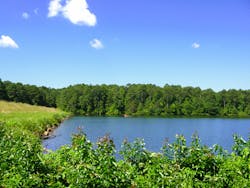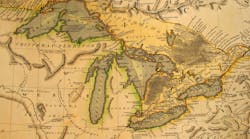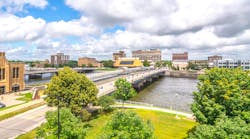Climate change both impacts and is affected by the ways we live, work and play. Corridors - built and natural - are passageways and linkages that not only facilitate activities in our daily lives but provide both scale and impact with regards to the viability of both built and natural systems. Corridors encompass and connect landscapes, geographies, jurisdictions, and the constituents they represent for specific purposes. Corridors facilitate market-driven value chains for consumers, industries, and communities. They also provide an ecological framework for scaled systems approaches, thus implicated in environmental policies, practices and technologies to reduce pollution impacts within certain geographic regions, such as that of state implementation plans (SIPs) for meeting ambient air quality standards or total maximum daily loads (TMDL) for meeting water quality standards in specific waterways, thus underscoring the diverse nature and dynamics of corridors.
Along these lines, one type of corridor concept that is resonating across a number of sectors is that of a Climate-Smart Resilient Green Corridor (CSRGC) – nature-based, climate sensitive, partnership-driven and equity-oriented, it uses identified impacts and opportunities within the corridor to achieve net zero climate and environmental outcomes, along with targeting equitable opportunities for improved community health and economic viability. Green, natured-based approaches are prioritized within CSRGCs, along with larger scale green investments that drive market competition and reduce overall costs while increasing economic investments and job growth opportunities throughout the Corridor.
The CSRGC construct ideally works within a watershed system context to drive innovative design, practices, technologies and jobs across the water, energy, and food (W.E.F.) spectrum, while reducing waste streams to better achieve net zero impacts for the whole of the watershed corridor.
The CSRGC optimizes MS4 program implementation by leveraging decentralized, distributed infrastructure opportunities to target green infrastructure(GI) and nature-based approaches (e.g., green streets with solar-led lighting or regenerative farms with enhanced green infrastructure bioretention and net-xero manure management for preventing nutrient runoff downstream and GHGs, along with solar panels for use of renewable energy, housing and schools with GI and solar) that enable greater collective resource investments, impact and outcomes. The CSRGC Corridor has key geospatial, temporal and technological aspects, including the address of upstream and downstream watershed impacts, which ensure for success. By planning, supporting, and placing complementary practices and technologies in close and/or strategic proximity, the dynamics and outputs from one facility and/or practice can positively support another versus having a negative impact.
A CSRGC’s watershed driven use of decentralized green infrastructure can help control flooding and water quality, encourage groundwater replenishment, and lessen the need for new grey infrastructure. Those grey elements like detention ponds and various storage chambers and valves can be optimized to minimize peak flows using smart technology, such as Continuous Monitoring and Adaptive Control (CMAC). Applications of these technologies at the site level can have profound impacts related to the reduction of flooding impacts during large storm events and enhance water quality treatment. At the corridor scale, they can collectively minimize erosive or damaging flows or pollutants in upstream and downstream, allow trade-off of flows per hydraulic and hydrology dynamics to minimize erosive or damaging flows and/or pollutant loads and institute a peak flow threshold for varying flows to minimize erosive or damaging flows and/or pollutants in all applicable parts of the watershed corridor.
An innovative tool which can support the CSRGC approach is that of the Watershed Resources Registry (WRR) (https://watershedresourcesregistry.org). Developed by US EPA Region 3 in partnership with USACE, USDOT/FHWA, Maryland State Highway Administration, Maryland Department of Natural Resources, Maryland Environmental Services, Maryland Department of Environment and numerous other partners, its purpose was to integrate and streamline the address of stormwater, wetlands and other Clean Water Act regulatory requirements within a watershed context through improved identification and targeting of opportunity “sites” for restoration, mitigation and preservation. Sea-level rise, demographics and other environmental, social and economic data have also been incorporated for improved needs assessment.
Due to its success, the WRR has been adopted by multiple states for regulatory, watershed and climate-related applications. It has also assisted in expediting MS4 program compliance-related integrated green stormwater infrastructure planning and implementation, resulting in significant savings for municipalities.
For example, Prince George’s County Clean Water Partnership (CWP) (https://thecleanwaterpartnership.com/), used the WRR for analysis of integrated green stormwater infrastructure opportunities within the Anacostia River watershed corridor to help the successful installation of 2000 green acres in less than 3 years. The WRR not only succeeded in providing more than 96% accuracy for choosing the right locations but was adapted as both a transparent stormwater bmp mapping and outcomes reporting tool for the community to track actions and progress in meeting community needs and target outcomes.
The WRR directs users to a variety of effective potential stormwater management sites that are strategic for restoring healthy hydrology and maximizing watershed and climate resilience benefits. The tool leverages a host of existing GIS data — from soils to 303(D) impaired streams, along with demographics, sea level rise, transportation networks and other land-use data. It also allows for importing of data and mapping outputs from other GIS screening tools such as EJ-Screen.2.1 (https://www.epa.gov/ejscreen), the Whitehouse Climate and Environmental Justice Screening Tool (CJEST - https://screeningtool.geoplatform.gov/) to include disadvantaged communities and census tracts that are overburdened and underserved, along with the First Street Foundation Climate Risk mapper (https://firststreet.org/risk-factor/) to include climate risks – flooding, drought, wildfires, etc. While users still need to ground truth selected WRR locations to determine which is best for their specific needs, the WRR can significantly reduce site assessment time and resources spent on the ground.
Tools such as the WRR along with complementary technologies and practices can unlock the potential for CSRCGs to cost effectively expedite and enhance the use of green, climate-friendly nature-based practices for MS4 community implementation and facilitate greater collaboration between the numerous MS4 communities – cities and towns and townships to create and achieve greater collective value and outcomes towards economic, environmental and public health resilience and sustainability.






